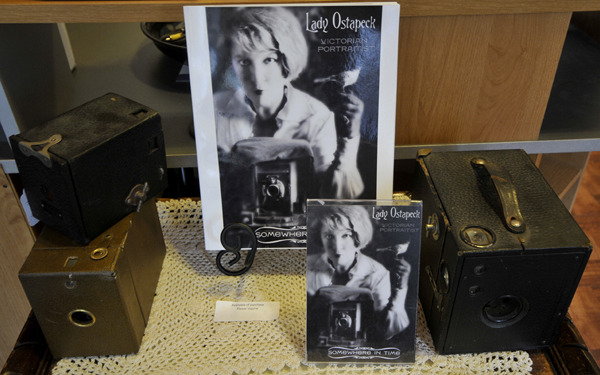2010 In the Media

Two Unique Representations of the Self: Autobiography, Review; Photography Center of the Capital District
By Richard Kornak, Assistant Editor of The Free George
 The marvelous, affecting exhibit, Autobiography, currently on display at the Photography Center of the Capital District, features the deeply personal photographic displays of artists Susanna Bartoldus and Nicholas Walster. Each photographer presents an intimate body of work, though their approaches to the art of self-reflection differ in entirely individualized ways.
The marvelous, affecting exhibit, Autobiography, currently on display at the Photography Center of the Capital District, features the deeply personal photographic displays of artists Susanna Bartoldus and Nicholas Walster. Each photographer presents an intimate body of work, though their approaches to the art of self-reflection differ in entirely individualized ways.
Bartoldus’s work is largely concerned with female inferiority, and is very symbolic. One of her series of photographs, called His-Story, examines the exclusion of women from divinity. These black and white photos present some kind of a religious image, be it a cross or an icon that is then set beside a stark representation of femininity. One photograph is of an anatomically-correct female doll’s body (perhaps a headless Barbie) on a crucifix, while another depicts a woman holding an apple in front of her genitals, with the letter e on each of her thighs, thus creatively forming the name Eve. The duality of the apple symbol, as both a forbidden object and a wholesome, American pie ingredient, is representative of Bartoldus’s metaphoric approach to photographic artistry.
Another of her memorable photographs is one titled Looking Back. A square-faced, beautiful woman looks to her right (the left side of the photograph), and a mirror is in the background. The mirror is covered in cobwebs (creating a redundancy in the title, as though the woman is looking back in time as well as in direction) and reflects the other side of the image of the woman looking to her right. Of course, there is the obvious irony that the reflected image, the woman in the mirror, is looking back, but there is something haunting about the photograph – the cobwebs and the colorlessness of the image create a ghostly atmosphere, and the way the woman’s face stays with you long after you leave the Photography Center is nothing short of spooky.
The curator of the Photo Center, Katherine, informed me that the model in Looking Back is a friend of Bartoldus’s, and that the artist uses that woman frequently, and always as a stand-in for herself. That bit of information, about Bartoldus’s friend serving as a stand-in for the photographer, as a fake reflection, a faux-Bartoldus, creates another ironic dimension to the photograph’s title, Looking Back, and made it the most effective photograph I saw.
 Nicholas Walster has a completely different take on self-reflective, autobiographical photography, and even takes it a step more literally. Using passages from his personal journals, Walster’s photographs are backdrops for his handwritten, actual autobiographical writings, which are transcribed over various images. The sprawling script gives the image behind it an almost fragmented feel, as though the ink from the written words divides and digitizes the photograph. Walster considers it a “symbol of how perception creates the world one witnesses.”
Nicholas Walster has a completely different take on self-reflective, autobiographical photography, and even takes it a step more literally. Using passages from his personal journals, Walster’s photographs are backdrops for his handwritten, actual autobiographical writings, which are transcribed over various images. The sprawling script gives the image behind it an almost fragmented feel, as though the ink from the written words divides and digitizes the photograph. Walster considers it a “symbol of how perception creates the world one witnesses.”
The fact that his vision is that of a world one witnesses is clearly evident; his is a very personal expression, including photographs of his dying father, his pregnant wife, and his newborn child. These personal images, when interlaced with those of worldly blossoms and flowering trees, give a full sampling of the images one might recall as memorably beautiful or poignant – at least, memorable enough to make their way into the impressionable, malleable thought stream.
Walster’s artwork is presented in panoramic form, with each panorama consisting of nine panels. He chose this form because he felt that it created the illusion of time unfolding, a spontaneous segue of memories.
While they are consistently made up of nine panels, nothing else about the panoramas is patterned or recognizably predictable. Some of the panels depict soft-focus images of vibrant flora. Others are nude portraits. There are photographs of decaying carcasses and wild fauna in motion, phallic cactuses and nineteenth century relatives of the artist. Life and death seem to be recurring themes, portrayed through images of both the natural, wild world and those that depict Walster’s immediate family members and distant relatives, who, when reduced to pictures on a panorama, seem equally eternal and transitory.

A Book and Two Videos for Lady O’s 92nd Birthday
In honor of Lady Ostapeck’s 92nd birthday the PhotoCenter is producing a book of her works, as well as offering two videos — Philip J. Marshall’s Lady With Horse documentary released in 2001 and Image Quilt’s Lady released in January of this year. Watch for oredering information coming soon.
Learn more about the video at www.imagequilt.com.

Back to Top

